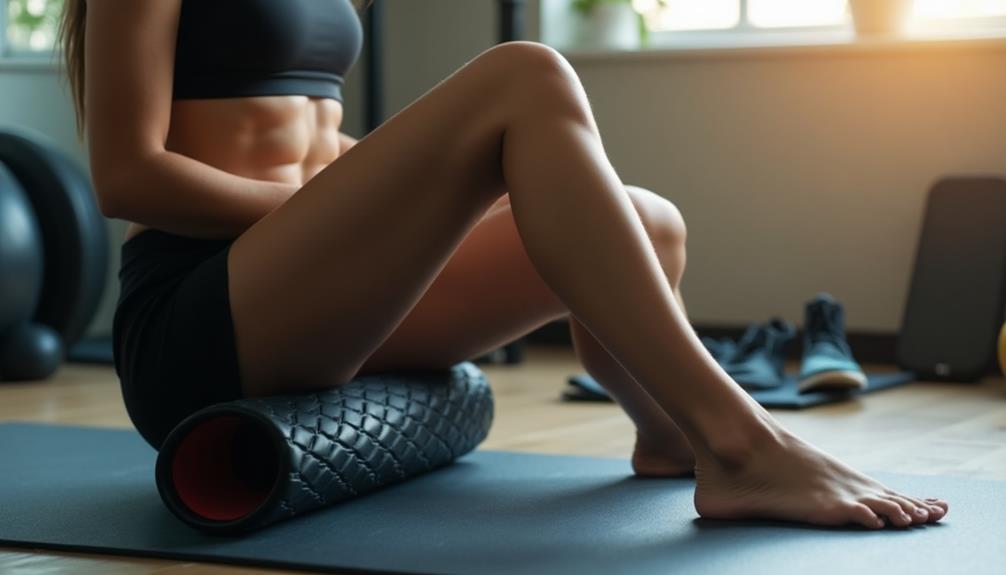Foam rolling is a fantastic way to reduce post-workout soreness and speed up recovery. Start with a high-density foam roller to apply firm compression on your muscles. Roll major muscle groups like quadriceps, hamstrings, and back by moving slowly and pausing on tight spots. For specific areas, gently roll calves from ankle to knee or relieve upper back tightness by lying horizontally on the roller. Timing matters, too; use foam rolling after workouts to aid recovery. Focus on breathing and consistent practice for the best results. You'll find more helpful tips and techniques as you explore further.
Core Insights
- Utilize a high-density foam roller on major muscle groups like quadriceps and hamstrings to effectively reduce soreness post-workout.
- Focus on rolling slowly over tight areas, pausing for 30 seconds to alleviate stubborn knots and tension.
- Incorporate techniques for specific sore areas, such as rolling calves from ankle to knee or upper back horizontally on the roller.
- Time your sessions post-workout to aid in recovery, improving blood flow and reducing muscle stiffness.
- Breathe deeply during foam rolling to enhance relaxation and promote myofascial release for better results.
Benefits of Foam Rolling
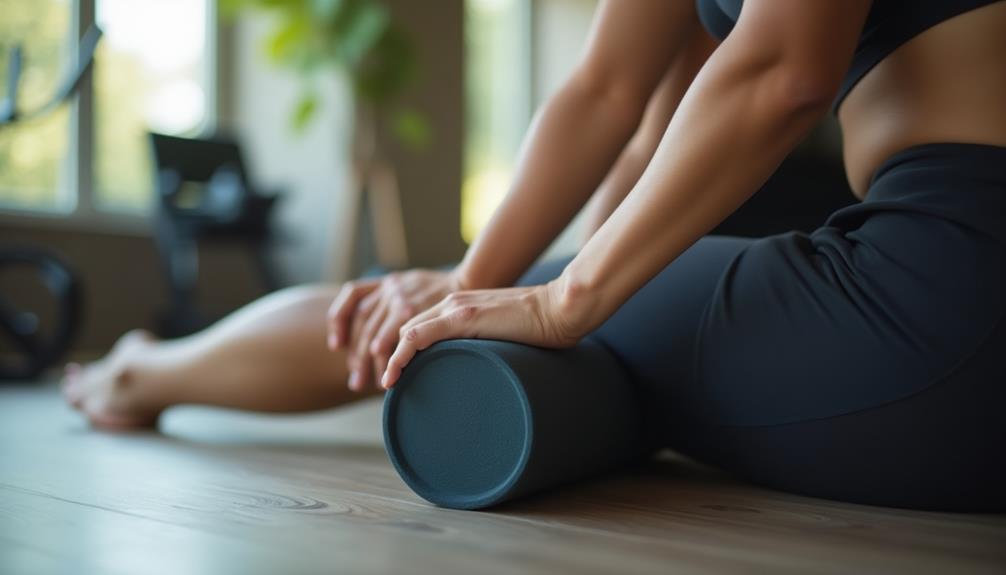
Foam rolling offers numerous benefits that can greatly enhance your post-workout recovery. First, it helps reduce muscle soreness and stiffness by promoting blood flow to your muscles. This increased circulation speeds up the delivery of nutrients and the removal of waste products, aiding recovery. High-density foam rollers provide firm compression for deep tissue massage, which can be particularly effective for targeting tight muscles and knots. These rollers are often recommended by physical therapists for their ability to provide intense pressure and promote myofascial release.
Additionally, foam rolling can improve your flexibility and range of motion. By targeting tight areas, you can release tension in your muscles and fascia, making it easier to perform exercises effectively.
Moreover, foam rolling can alleviate stress and promote relaxation, contributing to an overall sense of well-being. Incorporating this technique into your routine can lead to better performance in future workouts, making it a valuable addition to your recovery strategy.
Essential Foam Rolling Equipment

Choosing the right equipment is essential for maximizing the effectiveness of your foam rolling routine. Start with a foam roller, which comes in various densities and sizes. A standard roller is great for beginners, while a firmer one offers deeper tissue relief. High-density foam rollers are particularly effective for deep tissue massage and myofascial release, providing intense pressure to target stubborn knots and tension.
Next, consider a massage ball. These are perfect for targeting smaller muscle groups and hard-to-reach areas. They're especially useful for trigger points in the upper back and shoulders.
Techniques for Major Muscle Groups
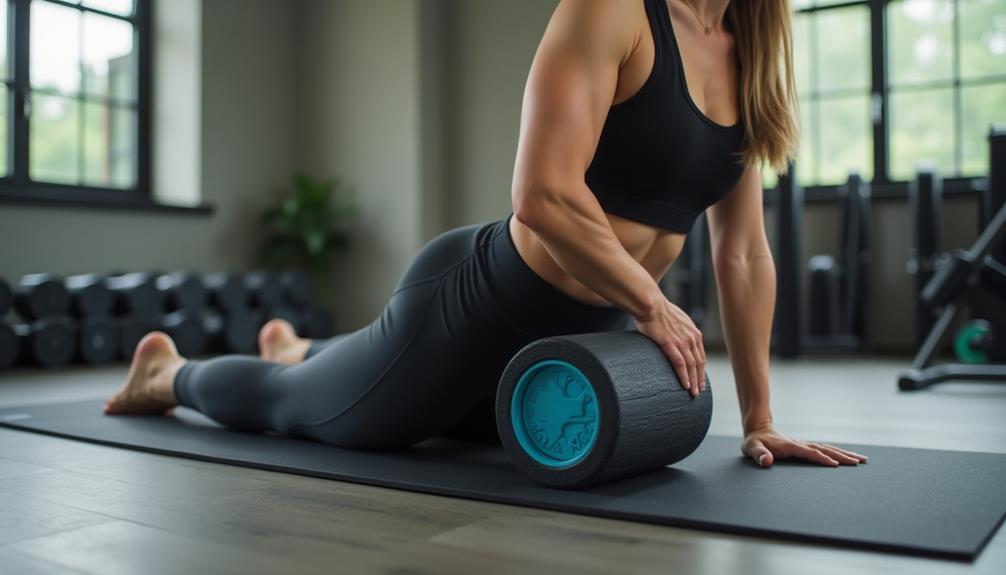
To effectively alleviate soreness in major muscle groups, mastering specific foam rolling techniques is key. Using a textured foam roller can enhance the myofascial release process, providing deeper tissue manipulation. Here are three essential techniques to target those areas:
- Quadriceps: Lie face down and place the foam roller under your thighs. Roll from your hips to your knees, pausing on any tight spots for 15-30 seconds.
- Hamstrings: Sit with your legs extended and place the roller under your thighs. Roll from your knees to your glutes, focusing on areas that feel particularly tight.
- Back: Lie on your back with the roller positioned under your upper back. Cross your arms over your chest, and roll from your upper to mid-back, taking care to breathe as you release tension.
Incorporating these techniques into your routine can greatly enhance recovery.
Targeting Specific Areas of Soreness
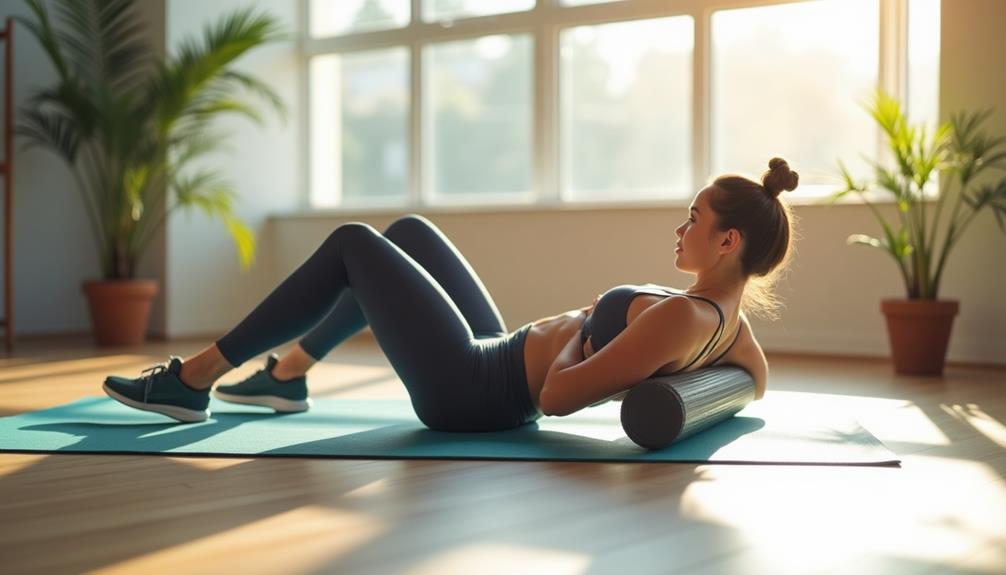
When you're dealing with localized soreness after a workout, targeting specific areas can make all the difference in your recovery. Start by identifying where you feel the most discomfort. For sore calves, position the foam roller under your lower leg and roll gently from the ankle to the knee. If your upper back is tight, lie on the roller horizontally and move your body back and forth to release tension. For stubborn knots, pause on the sore spot and apply gentle pressure for 20-30 seconds. Don't forget your hips; rolling over them can alleviate tightness that affects your overall mobility. By focusing on these areas, you can enhance your recovery, reduce soreness, and improve your performance in future workouts.
Timing Your Foam Rolling Sessions
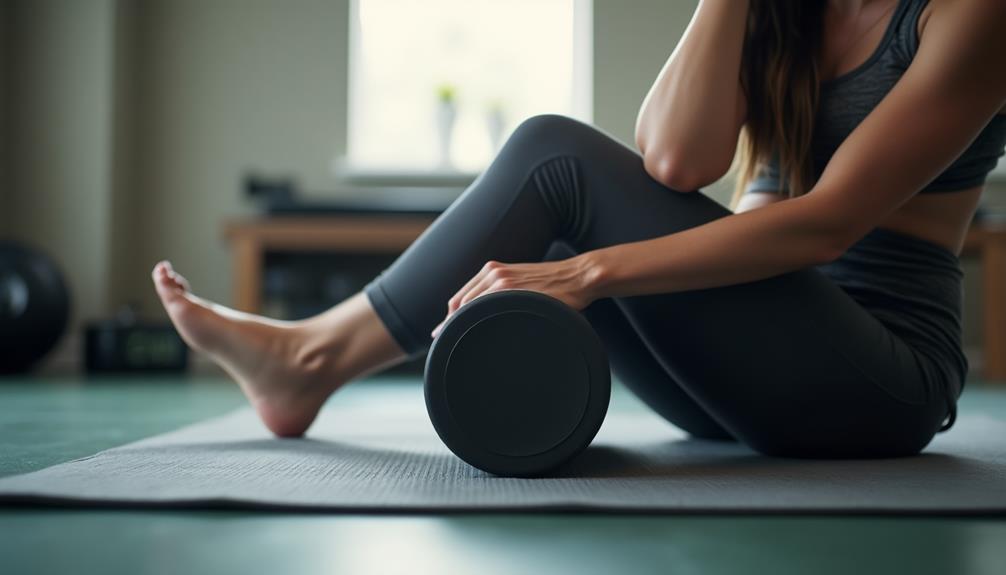
Timing your foam rolling sessions can greatly impact your recovery and performance. To maximize benefits, consider when you're rolling. Foam rolling can be effective both before and after workouts, but the timing may vary based on your goals.
- Pre-Workout: Use it to warm up muscles and increase blood flow.
- Post-Workout: Roll after your session to aid in recovery and reduce soreness.
- Rest Days: Incorporate foam rolling on off days to maintain muscle flexibility.
Tips for Effective Foam Rolling
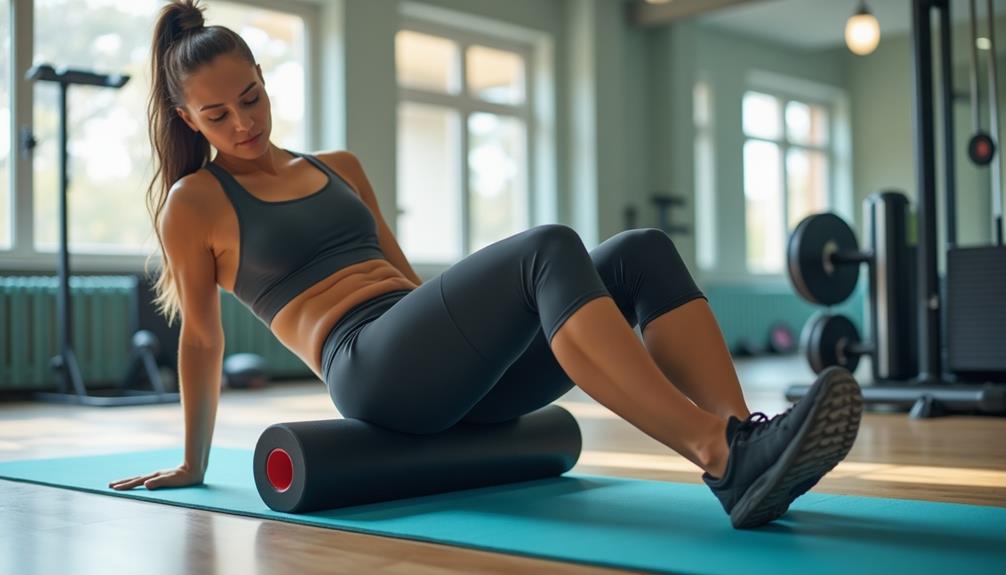
Effective foam rolling can greatly enhance your recovery process, and knowing a few key tips can make all the difference.
Start Slow
Begin with light pressure. Gradually increase the intensity as your muscles loosen up.
Target Key Areas
Focus on sore spots, but don't rush. Spend about 30 seconds on each tight area.
Maintain Control
Keep your movements slow and controlled. This helps you better identify knots or tightness.
Breathe
Remember to breathe deeply. This can help relax your muscles and improve your overall experience.
Consistency is Key
Incorporate foam rolling into your routine regularly for the best results. Aim for a few minutes after workouts or on rest days.
Frequently Asked Questions
Can Foam Rolling Help With Injury Recovery?
After spraining your ankle, you might find that foam rolling the surrounding muscles helps reduce tightness and improve circulation. Yes, foam rolling can aid injury recovery by promoting blood flow and enhancing flexibility in affected areas.
How Often Should I Foam Roll Each Week?
You should foam roll at least three to four times a week for best benefits. If you're pushing your limits in workouts, consider rolling more frequently to aid recovery and reduce muscle soreness effectively.
Is Foam Rolling Safe for Everyone?
Yes, foam rolling's generally safe for most people. However, if you've got specific injuries or conditions, it's best to consult a healthcare professional first. Listening to your body's signals is important for safe practice.
Can Children Benefit From Foam Rolling?
Yes, children can benefit from foam rolling! It helps them improve flexibility, reduce muscle tension, and enhance recovery after physical activities. Just make sure they use appropriate techniques and supervision to maximize safety and effectiveness.
What Should I Do if Foam Rolling Is Painful?
If foam rolling's painful, you should ease up on the pressure, focus on less sensitive areas, or try a softer roller. Listen to your body—discomfort's normal, but sharp pain isn't. Adjust accordingly for comfort.

